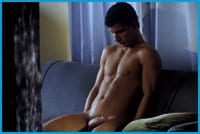Carlos Quiroz does not make porno-graphy. Though his photographs of male nudes have undoubtedly served as wank material for more than a few guys over the years, the Montreal-based artist draws a clear distinction between pornography and erotic art. “A lot of people want to call my work porn because I show sex organs. But there is so much attention paid to light and composition it’s clearly something else,” he says. “To me, pornography displays a sexual act in the crudest manner. Anyone can make porn.”
Art enthusiasts and porn-lovers alike can decide for themselves which category his work falls into with the series of his photographs from the late 1970s and early ’80s currently on display at the O’Connor Gallery. Previously only available in beefcake magazines, these works feature a series of exquisitely photographed hunky men in various poses and states of arousal.
“Perhaps because of our oversaturation with pornography, some gay men have become dismissive of male nudes,” says Dennis O’Connor, owner of the gallery. “One look at these works and you can tell they’re something special. Carlos is such a perfectionist, often making his models wait for hours, until he’s happy with the light coming in the windows of his studio.”
Originally from a small town in Peru, Quiroz first came to Canada in 1975 to visit his older brother who was then living in Montreal. Enamoured with the wider range of job prospects available to him in this country, he decided to make a permanent move. “I had a dream to change the world and I knew I couldn’t do it in Peru,” he says. “The only options there were to work for the communist government or the military. I didn’t want to do either.”
Quiroz was also drawn to the flourishing Montreal gay scene of the 1970s. “Gay life in Peru was very secretive,” he says. “There were no bars or discos. You had to hide who you were or someone might find out and tell your family. I was shocked to see people lining up outside gay clubs in Montreal without being afraid to be seen.”
The few gay friends he had made back home were hungry for queer culture and Quiroz would often send back gay magazines to them, including issues of The Body Politic (Xtra’s predecessor). “My friends didn’t speak much English, but they would gather in someone’s house to read it together,” he says. “Seeing a picture of two men embracing or reading discussions about sex was mind-blowing for them.”
It was also in the gay scene where Quiroz’s photography career began. He met his first model, a young Québécois man named Christian Marion at a leather bar called Bud’s. After some prodding by his friends, Quiroz approached the young stud and the two swapped phone numbers. They met up later that week at Christian’s pad to shoot some pictures. “I’ll never forget that first moment when he took off his pants,” Quiroz laughs. “He was so nice, so open. I’ve found that French-Canadians tend to be very comfortable with nudity.”
Quiroz went on to shoot for a bunch of beefcake magazines including Honcho, Blue Boy and Torso, to name a few. It was around this time that he started publishing his photos under the name Lobo (the Spanish word for wolf). It was common for beefcake photographers to work under a pseudonym, as a means of protecting their identity and avoiding arrest. Quiroz, however, asserts he wasn’t trying to hide anything. “I was proud of the work I was doing,” he says. “The publisher I was working for just wanted me to take an assumed name to make it look like he had exclusive rights to a particular photographer.”
This meant that audiences of his later work, after he’d reverted to publishing under his birth name, didn’t connect him to his earlier pieces; he’s now 57 and still working. When Quiroz first met O’Connor he asked him what kind of images he was particularly drawn to. O’Connor replied that he’d always liked this one photo-grapher and pulled out a magazine that featured some of the Lobo photographs. Quiroz spent a few moments rummaging though his studio, and returned with a photograph of one of the same models. When O’Connor inquired how he’d come across an original Lobo, he replied simply, “I am Lobo.”
Though his work has made a substantial contribution to the visual landscape of gay culture, Quiroz doesn’t see himself as a political figure. “I was just trying to show people things they didn’t have access to otherwise,” he says. “Seeing images of the nude body goes beyond making a political statement. It’s about consolidating our identity as gay people and creating a feeling of security around our sexual desires.”
O’Connor asserts that Quiroz’s work does have political significance — whether he intended it or not. “When people are engaging in illegal activities, whether it’s taking nude photos or getting a blowjob in a park, they aren’t thinking about forwarding a political cause,” O’Connor says. “The truth is everything we do as gay people, every expression of sexuality we make, contributes to the political landscape.”


 Why you can trust Xtra
Why you can trust Xtra


